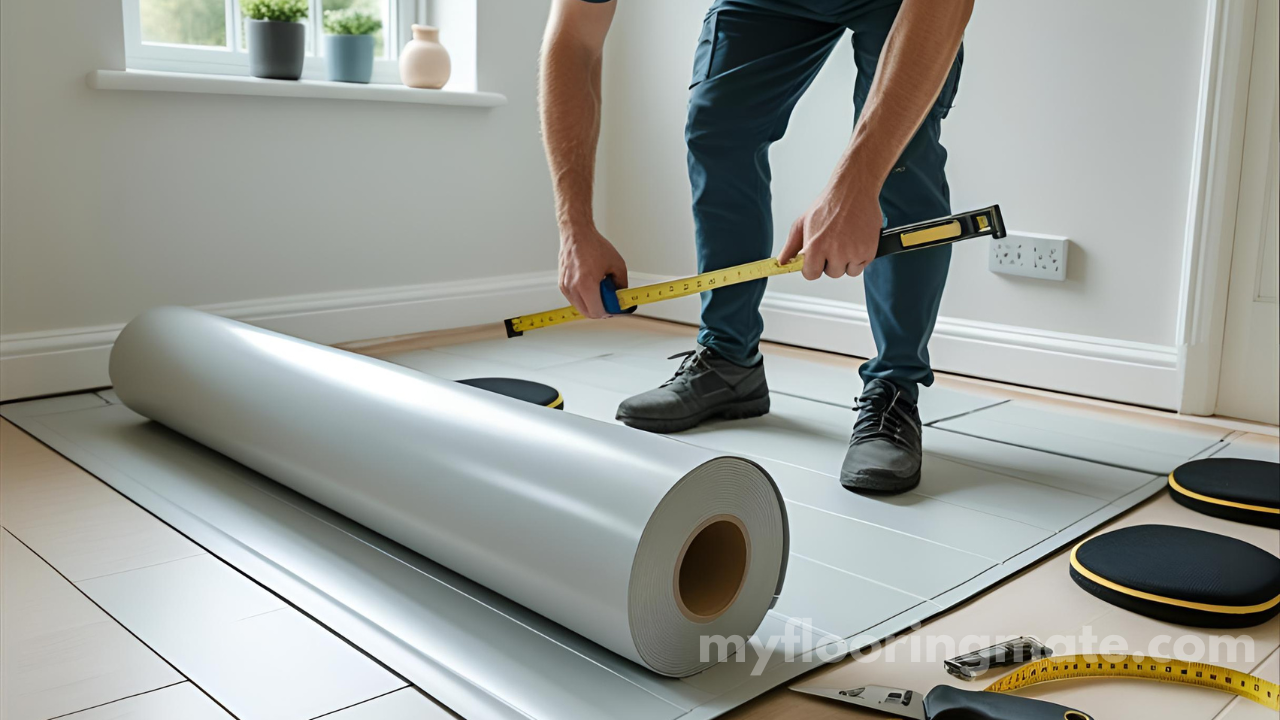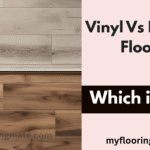Introduction
I’ve spent over 15 years fitting and advising on vinyl flooring in homes all across the UK. One question I get asked a lot is: do you need underlay for vinyl flooring? The answer isn’t the same for every floor—it really depends on the type of vinyl and the condition of your subfloor.
Using the right underlay for vinyl flooring can make your floor more comfortable, quieter, and protect it from moisture. But with different vinyl options like click vinyl (LVT) or glue-down sheet vinyl, the need for underlay changes.
In this guide, I’ll share clear, practical advice from my years of experience to help you decide if you need underlay and how to pick the right one. Whether you’re doing it yourself or working with a professional, this advice will help your vinyl floor last longer and look great.
What Is Underlay & Why It Matters for Vinyl Flooring

As a flooring expert with years of experience working on UK homes, I’ve seen how often people underestimate the role of underlay when installing vinyl floors. Simply put, underlay is a thin layer of material placed between the subfloor and your vinyl flooring. Its main purpose is to provide a smooth, stable surface that improves comfort, insulation, and soundproofing.
The core functions of vinyl flooring underlay include evening out minor subfloor imperfections, offering thermal insulation to keep your home warmer, absorbing sound to reduce noise, and in some cases, acting as a moisture barrier. Unlike carpet underlay, which is soft and thick, the ideal underlay for vinyl flooring is firm and thin to support the floor’s durability.
From my years on site, I can tell you that the right underlay for vinyl flooring and how to choose the best underlayment for floors to makes a noticeable difference—especially with click vinyl (LVT) or floating vinyl floors. It helps the floor perform better and last longer while making your home more comfortable and quieter.
Understanding what is underlay and its importance is essential for anyone planning a vinyl floor installation. In the following sections, I’ll explain exactly when you need underlay and how to choose the right one, so your floor installation is both smooth and successful.
When You Need Underlay for Vinyl Flooring

Having installed and inspected hundreds of vinyl floors across UK homes, I know firsthand when underlay for vinyl flooring is essential to a successful installation. Using the right underlay can prevent issues like uneven wear, cold feet, and noisy footsteps that often cause frustration down the line.
One of the most common cases is with click vinyl flooring, also known as LVT (luxury vinyl tiles), which are installed as floating floors. Because these floors aren’t glued down, a proper underlay creates a stable, cushioned base. This not only improves comfort underfoot but also significantly reduces sound transmission—a key concern in multi-storey homes or flats.
In many UK properties, concrete subfloors are the norm, especially in basements and ground floors. From my experience, installing a quality vinyl click flooring underlay over concrete adds important insulation and warmth, helping to maintain a cosy environment throughout the year.
Additionally, if soundproofing or extra cushioning is a priority—such as in upstairs bedrooms or busy family homes—underlay plays a vital role in absorbing impact noise and creating a quieter, more comfortable living space.
To sum up, based on years of professional flooring work, the answer to Do you need underlay for vinyl flooring is yes when:
* Installing click vinyl (LVT) using a floating floor method
* Your subfloor is uneven, hard, or cold—common with concrete floors in the UK
* You want enhanced comfort, warmth, or soundproofing in your home
Choosing the correct underlay for concrete floors or floating vinyl not only ensures your floor lasts longer but also meets UK building standards and homeowner expectations.
When You Don’t Need Underlay

In my many years fitting vinyl flooring across UK homes, I’ve also seen situations where using underlay for vinyl flooring is unnecessary—or even harmful. Knowing when to skip underlay is just as important as knowing when to use it, especially to avoid issues that can affect your floor’s warranty and long-term performance.
For instance, glue-down vinyl flooring and sheet vinyl products typically don’t require underlay. These types of vinyl are designed to be installed directly onto the subfloor, providing their own stable base. Adding an underlay beneath glue-down vinyl can interfere with the adhesive bond, causing bubbling, lifting, or premature wear.
Similarly, many vinyl floors come with vinyl flooring with built-in underlay or an attached backing that provides cushioning and moisture protection. Installing extra underlay over these can create instability, reduce floor durability, and may void the manufacturer’s warranty. It’s crucial to follow the vinyl floor prep instructions and check product specifications before adding any additional underlay.
In summary, the answer to do you need underlay for vinyl flooring is NO when :
* Using glue-down vinyl or sheet vinyl flooring
* The vinyl has a built-in underlay or attached backing
* Manufacturer guidelines advise against underlay to protect your warranty
Avoiding unnecessary underlay in these cases ensures your vinyl floor remains stable and performs well, saving you from costly repairs and maintaining the floor’s lifespan.
How to Choose the Right Underlay for Vinyl Flooring

Choosing the right underlay for vinyl flooring is crucial to ensure your floor performs well and lasts for years. Based on my extensive experience installing vinyl floors across UK homes, I always recommend considering a few key factors before making a decision.
First, thickness matters. Vinyl floors need a firm, low-profile underlay—too thick or soft, and it can cause uneven wear or affect the floor’s locking mechanism, especially with click vinyl (LVT). Typically, underlay thickness for vinyl ranges between 1mm and 3mm, striking the right balance between comfort and support.
Next, check compatibility. Not all underlays work well with vinyl. Some are designed for carpet or laminate and can retain moisture or be too soft. Look specifically for vinyl flooring underlay options that are compatible with your type of vinyl and the installation method.
Moisture resistance is another critical consideration, especially if you’re installing over concrete or in rooms prone to dampness. Using a damp-proof membrane or an underlay with built-in moisture protection can prevent damage and mould growth. In many UK homes with concrete subfloors, this is a must-have.
Sound insulation is often overlooked but important, particularly in flats or multi-storey homes. A good quality underlay with acoustic rating helps reduce noise from footsteps and vibrations, improving your home’s comfort.
When choosing, I recommend looking for underlay products specifically marketed as best underlay for vinyl flooring UK. Trusted brands often meet British standards and come with manufacturer guarantees, giving you peace of mind.
In summary, to pick the right underlay, consider:
- Appropriate thickness (1-3mm) for stability and comfort
- Compatibility with your vinyl type and installation method
- Moisture resistance for damp or concrete subfloors
- Acoustic properties for soundproofing
Making the right choice on flooring insulation UK homes ensures your vinyl floor not only looks great but performs reliably for many years.
Installing Underlay for Vinyl Flooring (Expert Tips)

From my many years on-site installing vinyl floors across UK homes, I can confidently say that proper installation of underlay for vinyl flooring is just as important as choosing the right product. Getting the installation right ensures your floor feels comfortable, performs well, and lasts for years without issues.
Before you start, make sure your subfloor is clean, dry, and level. Uneven or dirty subfloors can cause problems like lumps or gaps under your vinyl. For concrete subfloors, it’s essential to check for moisture and use a suitable damp-proof membrane if needed.
When laying your vinyl flooring underlay, start at one corner and roll it out smoothly, avoiding wrinkles or folds. Make sure the underlay edges butted tightly together—never overlapping, as this can cause bumps in your floor. Use quality tape designed for flooring underlay to seal seams securely.
Pay close attention to the orientation of the underlay—some have a specific “top” side that must face up. Installing it upside down can reduce its effectiveness in insulation or moisture protection.
Avoid common mistakes like using carpet underlay under vinyl or doubling up underlays, which can cause instability and void warranties. Also, never install underlay over existing flooring unless the product specifically allows it.
Tools you’ll need include a utility knife for cutting underlay to size, measuring tape, and underlay tape. Take your time with preparation—it makes the actual vinyl installation smoother and prevents costly errors.
In summary, here are my top tips for how to lay underlay for vinyl flooring successfully:
* Ensure the subfloor is clean, dry, and level before starting
* Use a suitable vinyl underlay fitting guide and follow manufacturer instructions carefully
* Lay underlay flat without overlaps, taping seams properly
* Make sure the correct side faces up for moisture and insulation benefits
* Avoid carpet underlay or excessive thickness under vinyl floors
By following these steps, you’ll give your vinyl flooring the perfect foundation, improving durability, comfort, and soundproofing for years to come.
Common Mistakes to Avoid

Having installed vinyl flooring in countless UK homes, I’ve seen some common mistakes that can easily be avoided when working with underlay for vinyl flooring. Avoiding these pitfalls not only protects your investment but also ensures your floor looks great and performs well for years.
One of the biggest errors is using carpet underlay under vinyl flooring. While it may seem like a quick fix, carpet underlay is often too soft and thick for vinyl, causing uneven support and premature wear. Always choose an underlay specifically designed for vinyl floors.
Another frequent mistake is doubling up on underlays—either by adding extra padding under vinyl with built-in backing or layering two different types of underlay. This can create instability and may void your floor’s warranty.
Skipping underlay altogether when it’s needed is another costly error. For example, laying **click vinyl (LVT)** directly on an uneven or cold **concrete floor** without the proper **vinyl click flooring underlay** can lead to uncomfortable floors, increased noise, and faster wear.
Failing to inspect and prepare your subfloor before installation is also a common oversight. A poorly prepared subfloor with dust, moisture, or unevenness will affect how well your underlay and vinyl flooring perform.
To sum up, avoid these mistakes:
* Using the wrong type of underlay like carpet underlay under vinyl floors
* Doubling up on underlays or adding extra padding unnecessarily
* Laying vinyl without underlay when required, especially on concrete floors
* Not properly preparing and checking the subfloor before installation
By steering clear of these common errors, you’ll protect your floor’s lifespan, maintain manufacturer warranties, and enjoy a smooth, comfortable finish that reflects the quality of professional UK flooring installations. I think with this detail you get the answer for do you need underlay for vinyl fooring.
check our latest post on Tools Needed to Install Vinyl Plank Flooring
FAQs ( Frequently asked Questions )
Here are some of the most common questions UK homeowners ask about underlay for vinyl flooring—answered with clear, expert advice:
Do I need underlay with vinyl flooring?
It depends on the type of vinyl. If you’re using click vinyl flooring (LVT), then yes—you’ll need an underlay for vinyl flooring to help with comfort, soundproofing, and stability. But if you’re installing glue-down vinyl or sheet vinyl, underlay is usually not needed and might even cause problems.
What underlay goes under vinyl click flooring?
For vinyl click flooring, choose a thin, firm underlay made for LVT. Look for products that are around 1–3 mm thick and offer moisture resistance and sound insulation. Avoid anything too soft, like carpet underlay.
Is underlay necessary for vinyl sheet flooring?
Most of the time, no. Sheet vinyl flooring is usually glued straight to the subfloor and often comes with a backing already. Adding underlay underneath can stop it from sticking properly and may even void the warranty.
Can I use carpet underlay under vinyl flooring?
No. Carpet underlay is too soft and thick for vinyl floors. It can cause movement, make the floor unstable, and damage the locking system—especially with click vinyl. Always use an underlay designed for vinyl flooring.
How thick should underlay be for vinyl flooring?
The best vinyl flooring underlay is about 1 to 3 mm thick. It should be firm, not spongy. This helps keep the floor stable, supports the locking system, and adds a bit of comfort and noise reduction without making the floor feel bouncy.
Final Thoughts ( Do you need underlay for vinyl flooring )
After working in flooring for over a decade, I can confidently say that underlay for vinyl flooring is one of the most misunderstood parts of a flooring project. Some homes absolutely need it — others don’t. It all comes down to the type of vinyl flooring, your subfloor condition, and whether the product already has built-in underlay.
To keep it simple:
* You need underlay for most click vinyl flooring (LVT) setups — especially on concrete floors or in flats where sound insulation is a priority.
* You don’t need underlay for glue-down vinyl or sheet vinyl flooring — and adding one could cause more harm than good.
* Always check the manufacturer’s instructions, and don’t assume one type of underlay fits all floors.
Using the right underlay improves comfort, reduces noise, and protects your flooring over time. But choosing the wrong one — or skipping it when you shouldn’t — can shorten your floor’s life and cost you money in the long run.
If you’re ever unsure, speak to a qualified flooring expert (or drop me a message — I’m always happy to help). In the end, getting the underlay choice right is just as important as choosing the vinyl itself.







